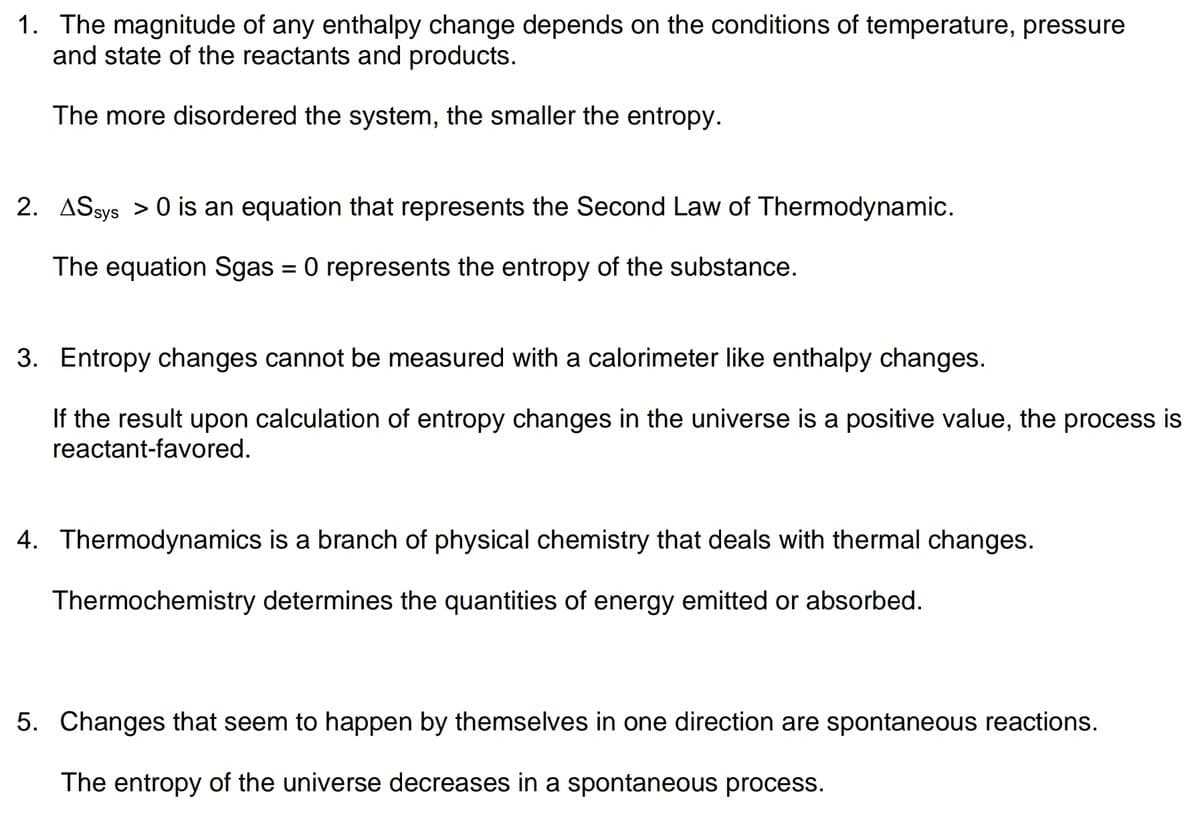1. The magnitude of any enthalpy change depends on the conditions of temperature, pressure and state of the reactants and products. The more disordered the system, the smaller the entropy. 2. ASsys > 0 is an equation that represents the Second Law of Thermodynamic. The equation Sgas = 0 represents the entropy of the substance. %3D 3. Entropy changes cannot be measured with a calorimeter like enthalpy changes. If the result upon calculation of entropy changes in the universe is a positive value, the process is reactant-favored.
1. The magnitude of any enthalpy change depends on the conditions of temperature, pressure and state of the reactants and products. The more disordered the system, the smaller the entropy. 2. ASsys > 0 is an equation that represents the Second Law of Thermodynamic. The equation Sgas = 0 represents the entropy of the substance. %3D 3. Entropy changes cannot be measured with a calorimeter like enthalpy changes. If the result upon calculation of entropy changes in the universe is a positive value, the process is reactant-favored.
Chemistry
10th Edition
ISBN:9781305957404
Author:Steven S. Zumdahl, Susan A. Zumdahl, Donald J. DeCoste
Publisher:Steven S. Zumdahl, Susan A. Zumdahl, Donald J. DeCoste
Chapter1: Chemical Foundations
Section: Chapter Questions
Problem 1RQ: Define and explain the differences between the following terms. a. law and theory b. theory and...
Related questions
Question
Answer number 1 to 5 and pls follow the instruction on the first picture.

Transcribed Image Text:1. The magnitude of any enthalpy change depends on the conditions of temperature, pressure
and state of the reactants and products.
The more disordered the system, the smaller the entropy.
2. ASsys > 0 is an equation that represents the Second Law of Thermodynamic.
The equation Sgas = 0 represents the entropy of the substance.
%3D
3. Entropy changes cannot be measured with a calorimeter like enthalpy changes.
If the result upon calculation of entropy changes in the universe is a positive value, the process is
reactant-favored.
4. Thermodynamics is a branch of physical chemistry that deals with thermal changes.
Thermochemistry determines the quantities of energy emitted or absorbed.
5. Changes that seem to happen by themselves in one direction are spontaneous reactions.
The entropy of the universe decreases in a spontaneous process.

Transcribed Image Text:MODIFIED TRUE OR FALSE.
Write the CAPITAL Letter of the correct answer.
A if both statements are true
B if the 1st statement is false and the 2nd is true
C if the 1st statement is true and the 2nd is false
D if both statements are false
I.
Expert Solution
This question has been solved!
Explore an expertly crafted, step-by-step solution for a thorough understanding of key concepts.
This is a popular solution!
Trending now
This is a popular solution!
Step by step
Solved in 4 steps with 3 images

Knowledge Booster
Learn more about
Need a deep-dive on the concept behind this application? Look no further. Learn more about this topic, chemistry and related others by exploring similar questions and additional content below.Recommended textbooks for you

Chemistry
Chemistry
ISBN:
9781305957404
Author:
Steven S. Zumdahl, Susan A. Zumdahl, Donald J. DeCoste
Publisher:
Cengage Learning

Chemistry
Chemistry
ISBN:
9781259911156
Author:
Raymond Chang Dr., Jason Overby Professor
Publisher:
McGraw-Hill Education

Principles of Instrumental Analysis
Chemistry
ISBN:
9781305577213
Author:
Douglas A. Skoog, F. James Holler, Stanley R. Crouch
Publisher:
Cengage Learning

Chemistry
Chemistry
ISBN:
9781305957404
Author:
Steven S. Zumdahl, Susan A. Zumdahl, Donald J. DeCoste
Publisher:
Cengage Learning

Chemistry
Chemistry
ISBN:
9781259911156
Author:
Raymond Chang Dr., Jason Overby Professor
Publisher:
McGraw-Hill Education

Principles of Instrumental Analysis
Chemistry
ISBN:
9781305577213
Author:
Douglas A. Skoog, F. James Holler, Stanley R. Crouch
Publisher:
Cengage Learning

Organic Chemistry
Chemistry
ISBN:
9780078021558
Author:
Janice Gorzynski Smith Dr.
Publisher:
McGraw-Hill Education

Chemistry: Principles and Reactions
Chemistry
ISBN:
9781305079373
Author:
William L. Masterton, Cecile N. Hurley
Publisher:
Cengage Learning

Elementary Principles of Chemical Processes, Bind…
Chemistry
ISBN:
9781118431221
Author:
Richard M. Felder, Ronald W. Rousseau, Lisa G. Bullard
Publisher:
WILEY